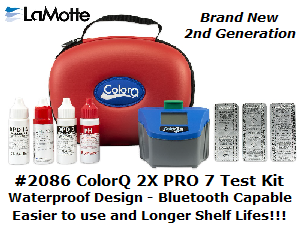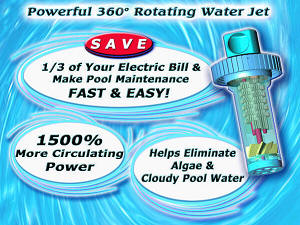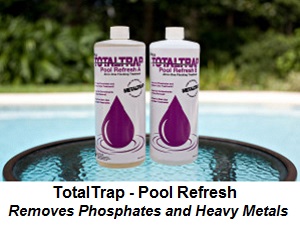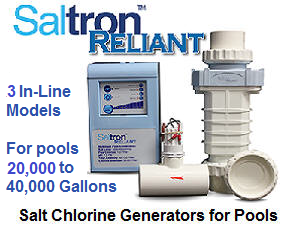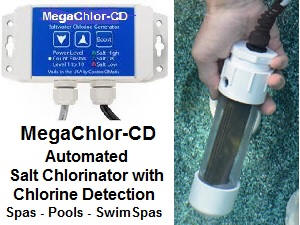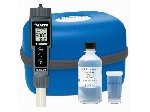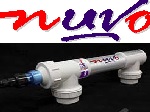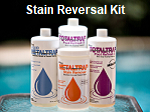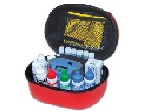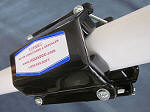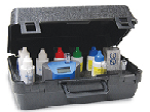|
 |
Shipping is FREE* . . . within
the Continental U.S.
A $9.99
handling charge will apply
to Continental U.S. Orders,
under $75.00. Orders
outside of the Continental
U.S. may require some
additional charge, based on
quantity and destination.
Most products can be
shipped World-Wide. International
and orders outside of
Continental U.S. - see
comments on the ordering
pages. |
|
 |

Major
Credit Cards and PayPal are accepted. |
|
On-line
shopping since 2002 - Safe and Secure!!! |
|
Optimizing chemistry, improving
circulation and eliminating
phosphates!!! |
|
Rashes,
irritations and odors can result, when
the water chemistry is out of balance.
The likelihood of algae, microbial growth
and sanitizer-resistant strains increases. A
ColorQ, All-Digital Water Tester
can perform all of the common pool water
tests and eliminates the color-matching
and guesswork. There is a model,
for every pool testing need.
Reliable water testing will help solve and avoid problems. Better
Circulation helps make everything work
more effectively. The
Circulator is a return jet
replacement fitting, that improves
filtration, eliminates the dead zones that
promote algae and microbial growth,
while improving sanitizer
distribution. Phosphates and Nitrates
can increase the growth of algae and
make sanitation more difficult, as both
are vital plant nutrients. Nitrate
removal is not practical, but phosphate
removal is easy enough to do.
Adding Pool
Refresh Total Trap will allow
you to vacuum and filter out phosphates
and should make algae control more
effective. |
|
|
If you have a pool or spa water testing
need, we should have the product.
►
Scroll down to read through some
Question & Answer information.
◄
|
|
Improving Sanitation With
Alternative Pool Water Sanitizers |
|
Rashes,
irritations and odors can become a
problem, when algae and microbial growth
are a frequent occurrence and is the result
of inadequate sanitation. as well as
other factors. Maintaining proper
sanitation and eliminating underwater
slimes, is a must. Adding some
backup sanitizing is important, as
chlorine level rise and fall, based on
pool usage and the chemicals being added. Most pools
use some sort of chlorine. A
Salt
Chlorine Generator is definitely
a better way to do chlorine. Salt
chlorine generators are highly automated
and give you better control. The
salt level is about that found in human
tears. In-Line and
no-installation-required models are
available.
A
PockeTester Kit
is a convenient way to monitor the salt
level,
in pools that utilize a salt chlorine
generator. |
|
|
If you have a pool or spa water testing
need, we should have the product.
►
Scroll down to read through some
Question & Answer information.
◄
|
|
How to avoid
common causes of rashes, irritations
and odors? |
Problems with a pool rash,
irritation
or unpleasant odors fall into several
categories. Some are bacterial infections caused
by inadequate pool water sanitizing, water
trapped in the ear or remaining in a damp
bathing suit for prolonged periods of time. Some
chlorine byproducts such as chloramines are
irritating and odorous and can lead to problems.
The difference between the Total Chlorine and
Free Chlorine reading is combined chlorine or
chloramines. Levels over 0.3 PPM are
associated with the onset of odors, irritation,
red-eye and water clarity problems. Some
individuals are highly sensitive to certain
chemicals or materials and can experience
problems, even though the pool is being properly
maintained. When the water chemistry and/or
sanitizer level is grossly out of balance, a
chemical dermatitis can be the result. All
instances of a rash or irritation should be
evaluated by a medical doctor. Individuals,
sensitive to even normal levels of common
sanitizers, may be helped by a switch to an
alternative sanitizer or combination of
sanitizing methods, such as:
Salt
Chlorine Generators and
Ultraviolet Pool Sterilizers. If problems
arise, refer to the
Pool Problems
Page, as a source of problem-solving
information, broken down into various
categories. Scroll down the page and click on the linked
keywords,
catch phrases
or images, in the archived answers below, to access additional information, on that topic or product.
Do you know what's in
your water? If you're having problems, with
sanitation or water clarity, testing allows you to better
understand the chemistry and determine the cause of the
problem. Once understood, you can select the best
treatment option. Understanding the nature of the
problem, should be step one. For information about
our full selection of testing options, visit our
Test Equipment Store.
 |
Join our E-Letter Mailing List.
You'll receive 1-3 E-Letters a
month, featuring helpful pool
and spa advice, new product
information and sale
announcements. All we
require is your e-mail address
and you can opt out anytime you
wish.
Your information
will never be shared or sold. |
|
▼
Helpful,
Problem-Solving Information, in a question and
answer format.
▼ |
►
Can COVID-19 present a risk, in a home spa or pool?
Is there any
advise about pool use, during the COVID-19 pandemic?
Brandon K.,
Melbourne, FL, 4/2/2020
There is no evidence that COVID-19 can be spread to
humans through the use of pools and hot tubs. Proper
operation, maintenance, and disinfection (e.g., with
chlorine and bromine) of pools and hot tubs should
remove or inactivate the virus that causes COVID-19.
The preceding information was taken directly for the CDC
website. Needless to say, you should adhere to social
distancing recommendations and limit the number of people,
in and around the pool. Now is not the time to have a
pool party. Use this link for the latest, from the
CDC:
https://www.cdc.gov/coronavirus/2019-ncov/php/water.html
Hopefully, this too will pass.
Stay well
and keep safe!!!
Alan
Schuster, 4/7/2020
►
Something Is Not
Right?
I go to a gym with a full size indoor salt water pool.
Several people including myself have gotten rashes and our
bathing suits get discolored and stretchy. I wore a brand
new one last week (shocking pink) and got out of the pool
with a purple suit. Any idea what is wrong? I also feel like
my face is picky and hot.
Thank you for your time.
Helen R., 6/8/2018

It sounds like the
chlorine level is very high. That could account for
the discomfort and the color change. A low pH would
make it even worse. The Center for Disease Control
(CDC) actually recommends that commercial pool users, such
as yourself, do some of their own water testing. They
suggested test strips, because of ease of use. A
LaMotte
Insta-Test 5 or Insta-Test 6 Test Strip should tell the
whole story, in just a dip of a strip. If things are
not right, you should complain and ask that conditions be
rectified, as soon as possible. If nothing is done,
there is always the department of health. I hope that this
will be helpful. If this website was helpful,
in solving your problem, please consider joining our
E-Letter Mailing List.
You'll receive E-Letters, with helpful
information, new product updates, suggestions and sale
announcements. I hope that I have
provided the solution.
Sincerely. Alan
Schuster, 6/8/2018
►
Smelly Pool Water?
Why does my
pool water have an unpleasant odor, sometimes? I can
add lots of shock to solve the problem, but why does it
happen? Thank you.
Samantha J.,
7/24/2017
Odors are usually directly
associated with inadequate sanitation. In chlorine
pools, it is the formation of chloramines, an odorous,
irritating and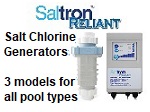 ineffective form of combined chlorine, that leads to odor
and irritation problems. The difference between the
total and free chlorine reading is combined chlorine and it
is recommended that the level be less than 0.3 PPM. About 10
PPM of free chlorine must be added to destroy 1 PPM of
combined chlorine. That is why shocking the pool
corrects the problem, at least until the next case of a
combined chlorine buildup. Organic wastes and urine,
in particular, are the common causes of the problem.
Not maintaining proper level of sanitizer only add to the
likelihood of odors, as well increasing the likelihood of
rashes and irritations. A
salt chlorine generator
is an ideal way to sanitize and eliminate chloramines,
because they are destroyed, as water passes through the salt
cell. Ultraviolet Sterilizers can also play an important role
in preventing odors, irritations and maintaining an optimum
level of sanitizer. In addition, maintaining proper
pool water chemistry is important, as it can directly affect
the effectiveness of chlorine sanitizers.
ineffective form of combined chlorine, that leads to odor
and irritation problems. The difference between the
total and free chlorine reading is combined chlorine and it
is recommended that the level be less than 0.3 PPM. About 10
PPM of free chlorine must be added to destroy 1 PPM of
combined chlorine. That is why shocking the pool
corrects the problem, at least until the next case of a
combined chlorine buildup. Organic wastes and urine,
in particular, are the common causes of the problem.
Not maintaining proper level of sanitizer only add to the
likelihood of odors, as well increasing the likelihood of
rashes and irritations. A
salt chlorine generator
is an ideal way to sanitize and eliminate chloramines,
because they are destroyed, as water passes through the salt
cell. Ultraviolet Sterilizers can also play an important role
in preventing odors, irritations and maintaining an optimum
level of sanitizer. In addition, maintaining proper
pool water chemistry is important, as it can directly affect
the effectiveness of chlorine sanitizers.
Sincerely.
Alan Schuster, 7/24/2017
►
Musty Smelling Hair And Bathing Suits?
What would
cause our hair and suits to smell musty after being in the
pool?
Ginger R.,
6/1/2015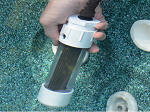
Test the Total and Free
Chlorine levels. The difference is combined chlorine.
Ideally, the combined chlorine should be less than 0.3 PPM.
Combined chlorine
irritating and odorous and could easily explain the problem,
that you are describing. To reduce the combined
chlorine level, it is necessary to shock the pool.
Each PPM of combined chlorine will require 10 PPM of free
chlorine, in order to reduce the level. Adding a
salt
chlorine generator or
ultraviolet sterilizer
are all very good ways to improve pool sanitation, while
eliminating combined chlorine. I hope that this
information is helpful.
Sincerely. Alan Schuster, 6/1/2015
► Are Foam Noodles
The Problem?
This is not a question so much as a
possible solution. I've been surfing for answers on a topic
I found on your site: pool rashes. I notice several people
have written regarding pool rashes-especially in "children
and teens" while the adults swam with no effects. Any rash
that persists more than 48 hours should be seen by a
physician, but I've been battling the same thing in my kids:
rash on the inner thighs down to the knees, sometimes up to
the groin area, always stops at the bathing suit line on my
daughter (girls' bathing suits have elastic legs). I think
the answer is simple--especially if the adults have no rash
but the children do. Pool noodles. The kids ride them. They
drag them up between their thighs and swim around with them.
My teenaged nephew visited and swam with a noodle under his
armpits and came up with a rash under his armpits. While
there's a good possibility that the chlorine levels in the
pool are too high, this should only cause dry skin and hair.
Chlorine levels would have to be extremely high to get a
chemical burn. If you think about how many gallons of water
there are, then a bit too high is really nothing. But not
only do the noodles come into direct contact with their
skin, but there is a good possibility of abrasion,
especially if the noodles are older and have begun
deteriorating. PLEASE make a note of this on your site. I
know people won't go and buy a bunch of test kits and new
chemicals as a result of reading it, but I really hate to
see $20,000 dollars worth of pool repairs when it's possible
it's the pool toys to blame! Always look into what comes
into direct contact with skin (other than just the water),
before panicking! Thanks!
Sheila. K., 8/8/2014
Your reasoning is sound and I agree that you may have found
a cause or at least a starting point. Abrade skin and a rash
is likely to follow. These noodles are very popular and this
is the first that I have heard of such a problem. However,
many products, made in Asia, seem subject to faster and
cheaper is best and that has lead to antifreeze in
toothpaste and melamine in milk products. Fiberglass fibers,
in deteriorated pool ladder rungs were found to cause thigh
rashes, as bathers exited. This letter has been posted and
that ladder product has been removed, from the marketplace.
I have gotten many letters about exposed fiberglass fibers
in pool refinishing compounds, that contain fiberglass. I
issue a warning about all such inquiries and it is the only
response letter, in which I use,
bold red type to highlight the potential
problems. I will add your letter, to the website. Perhaps,
you are not alone.
Sincerely. Alan Schuster, 8/9/2014
► What Causes
Red Eyes?
We have a small, 15 foot round
above-ground pool. My two kids have gotten "red eyes"
several times. Is there is a specific cause of this problem?
Thank you.
Melanie J., Easton, PA, 8/1/2016
Red eyes or stinging eyes are most likely an irritation
problem, caused by high levels of chloramines: an
irritating, odorous and ineffective form of combined
chlorine. Be certain to use a Free Chlorine Test Kit and
keep the Free Chlorine level at 1-3 PPM, as much of the time
as possible. Try and keep the Total Chlorine level, no more
than 0.3 PPM, above the Free Chlorine. This will keep the
amount of chloramines to a minimum. Small above ground pools
are especially vulnerable, because it can be quickly
depleted of all of the chlorine. Kids can spend a lot of
time in and under the water. Because there are small
children involved, I suggest that you test the Free Chlorine
level, before the pool is used. In addition, test at
the first signs of loss of water quality and periodically
throughout the day, depending upon the pool usage. The use
of a non-chlorine shock can help to reduce the chloramines
present in the water. Use it as needed. All medical
problems should be evaluated by a medical doctor. I hope
that I have been helpful.
Sincerely. Alan Schuster, 7/23/2016
► Salt Water
Pools and No Red Eyes?
Is there a way you can explain in
layman's terms to me why with a salt system pool there is no
red eye. I have been told that it due to no chloramines,
which man made chlorine contains. But, when I research it
seems as though chloramines are caused by nitrogen, which I
don't see on the labels of man made chlorine. Can you help
explain? Thanks.
Al, 12/15/2013

You're close, but all of the ducks are not in a row.
Chloramines are irritating forms of combined chlorine, that
are formed by the reaction of chlorine with nitrogenous
wastes. All chlorine is man-made and all chlorine can form
chloramines. Chloramine is not something that will appear on
any labels. What makes
salt chlorinating systems
different, is that 100% of the chloramines are destroyed, as
the water passes through the energized cell. This is not
true of any other means of adding chlorine. Inasmuch as
chloramines are the principal cause of "red eyes" this claim
is justifiable. Salt chlorine generators help produce
quality water with a minimal chemical presence. That typical
pool chlorine odor is actually chloramines and will be
virtually eliminated with a properly maintained salt
chlorinated pool. I hope that this information will prove
helpful. Enjoy the holidays.
Sincerely. Alan Schuster, 12/15/2013
►
Bloodshot
Eyes?
Can you please tell me what we are
doing wrong in two areas? For one my ladder keeps floating
up it has never really seemed to be installed right and now
two years later can't find the instructions. It doesn't seem
heavy enough to stay down in the water. The other problem is
with chemicals. I didn't have this problem last year and
don't know why. I do this year but I'm not showing "any"
chlorine in the pool according to my own tests and the ones
I take to the pool place. So I add more shock and my kids
come out with blood shot eyes and say its too much. HELP,
PLEASE!
Nichole D., 5/10/2007
So far as the ladder is concerned, there is nothing that I
can offer. Contact the manufacturer or discuss the problem
with a local dealer. The red eye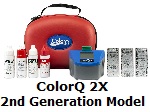 conditions that you are
describing are consistent with high levels of chloramines.
Chloramines will not show up on a Free Chlorine test. You
should test for Free and Total Chlorine: the difference
between these readings can be attributed to chloramines. If
the Total Chlorine reading is more than 1 PPM above the Free
Chlorine reading, it could be indicative of a problem. A
major cause of chloramine formation is urine in the pool.
The method for destroying chlorines is shock treatment.
However, after shock treatment the pool should not be used
until the chlorine level drop back into the optimum range of
1-3 PPM of Free Chlorine. Ultimately, bather comfort is
dependent upon the maintaining of proper pool water
chemistry and sanitizer levels. With water testing so
important, I suggest the use of the
all-digital, ColorQ
Water Analyzers. There is a model for every pool. It
eliminates all color-matching and guesswork. I hope that I
have been of assistance.
conditions that you are
describing are consistent with high levels of chloramines.
Chloramines will not show up on a Free Chlorine test. You
should test for Free and Total Chlorine: the difference
between these readings can be attributed to chloramines. If
the Total Chlorine reading is more than 1 PPM above the Free
Chlorine reading, it could be indicative of a problem. A
major cause of chloramine formation is urine in the pool.
The method for destroying chlorines is shock treatment.
However, after shock treatment the pool should not be used
until the chlorine level drop back into the optimum range of
1-3 PPM of Free Chlorine. Ultimately, bather comfort is
dependent upon the maintaining of proper pool water
chemistry and sanitizer levels. With water testing so
important, I suggest the use of the
all-digital, ColorQ
Water Analyzers. There is a model for every pool. It
eliminates all color-matching and guesswork. I hope that I
have been of assistance.
Sincerely. Alan Schuster, 5/11/2007
►
Strong Chlorine Odor?
My pool has a
terrible chlorine odor, although the total Chlorine reading
is not high. We are new pool owners and are not sure
what need to be done. Thank you for your help.
Carrie B.,
Cincinnati, Ohio 7/2/2014
Most likely, you are not
actually smelling chlorine, but are detecting the irritating
odor of chloramines. Chloramines are formed by
the reaction of chlorine with nitrogen containing wastes,
such as urine or sweat. Combined chlorine is the
difference between the Total and Free Chlorine readings and
is comprised mostly of chloramines. They are
irritating, odorous and ineffective as sanitizers. You
can detect chloramines at levels of as little as 0.1 PPM,
while it takes 30 PPM of chlorine to detect its odor.
To reduce chloramines to under the recommended 0.3 PPM, it
is necessary to shock the pool. Maintaining a
consistent, free chlorine level will help with this problem.
Adding a
salt chlorine generator
or
ultraviolet sterilizer
will help avoid chloramine
formation and enable you to maintain better quality.
I hope that this is helpful.
Sincerely. Alan
Schuster, 7/3/2014
► Rashes: An
International Story?
Dear Alan, we are having a problem
with a skin irritation from our pool water and hope that you
may have heard of this problem before. The skin rash is
usually located on the legs of the swimmers, looks like
small red dots and in some cases the skin sparkles like
glitter and feels like tiny prickles. The rash is only
noticed once the swimmer has dried themselves and usually
lasts about 24 hours, but is very tender to touch. Is this a
typical chloramine rash? Most of the people affected by
rashes are children and teenagers and the problem is not
just with our family members. Although I have had it myself
once, my husband has not. Last summer we were careful about
balancing our water and find it hard to accept that it could
have been chloramines or an imbalance of chemicals. So we
decided to have a water test at a laboratory. It was
confirmed that fine fibres were found, consistent with
fibreglass fragments, about 0.1mm or so long. From this
conclusion, we decided to re-fibreglass our pool this
summer, (as well as solving other problems - the bottom of
our pool was progressively becoming lumpier and we had a
black spot problem). We have since discovered the original
job was sprayed too thin and an isothelic resin may have
been used, where a vinyl resin would have been more suitable
in a heated pool.
However, after re-fibreglassing, filling the pool with fresh
tap water, balancing and heating the water, the children had
their first swim and came out with yet another rash. The
pool builder balanced the water for us and did not seem to
add anything out of the ordinary - salt, bicarbonate of
soda, hydrochloric acid, and a small amount of liquid
chlorine. He did not that the water in the filter and pipes
was very green and flushed this out, however, he said he was
unable to flush out the old water in the pipes returning to
the pool. Could this have been so contaminated?
For background information we have:
a new fibreglass pool interior using a vinyl ester resin
)perhaps some fibres were left in the pool? However the DE
filter is meant to filter out up to 3-5 microns).
salt chlorinator (Could there be a problem with the
electrolytic saline chlorination system?).
DE Filter (Filter not too small, it can handle up to
120,000L - we have only 77,000L and it is running for 10
hours a day in summer).
gas heat pump (We heat the pool to a delicious 28 - 30 C.
Could increasing the temperature affect chemical reactions
on the skin?).
solar pool blanket (Is stored outside and may be
contaminated from the sanding and re-fibreglassing chemicals
or UV deterioration).
concrete pavers surrounding the pool.
lots of organic matter blown into the pool esp. from an oak
tree.
Most of the equipment is around 9 years old now, with the
exception of the newly installed controller pH and Chlorine.
We will be sending more water to be analysed by a chemist
but we are not sure what to ask him to test for. We have
tried to think outside the square with all the variables but
as I am not a scientist I am struggling to come up with a
solution. We hope that you may have some ideas. Regards.
Carolyn M., New Zealand. 3/13/2005
That was quite a letter! The first thing that I would advise
is for those people with a pool rash to seek a medical
opinion. Fiberglass fibers can certainly be part of the
cause of the problem. I am not familiar with the resin
products and, therefore, I will be unable to offer any
definitive information concerning their use. It is extremely
unlikely, bordering on the remote, that chloramines are the
cause of this rash. If chloramines were the cause, you would
have mentioned that some or all of the bathers had "red
eyes." There was no such mention. Secondly, the fact that
you have a salt chlorinator means that all of the water
passing through the cell is free of chloramines: that is if
the equipment is working properly. Rashes can be caused by
bacteria, due to improperly sanitized water. However, I
doubt that this is the case. Bacterial rashes would affect
the folds of the bodies and the areas covered by bathing
suits. Again, nothing in your letter suggests that this is
the case. You had your water tested and professionally
balanced, so there is no reason to suspect a water chemistry
gone awry. The heating to 30șC is not part of the problem.
Where I live that is the normal summertime water
temperature. The debris from the oak tree might cause
staining, but it will be destroyed by the chlorine. The dust
from the pavers will be neutralized by the overall water
chemistry. All this brings us back to those fibers! The D.E.
filter should help remove them over time. You might use an
automatic pool vacuum in the morning before the pool has
been used. This will help speed up the removal. What you are
describing is not common. At least not from my vantage
point. Nothing points to a cause other than the fibers. If
the new surface is not contributing additional fibers, you
should see improvement over time. You might want to seek out
a source with more experience with fiberglass products. I
hope that I have been helpful. Good luck and let me know how
things turn out.
Sincerely. Alan Schuster, 3/13/2005
Dear Alan, thanks for your speedy
reply. By pure chance yesterday I was talking to a pool
valet man who said he'd heard of a case years ago in South
Africa where there was a problem with the pool ladder. I
hadn't even considered our pool ladder! It is stainless
steel with white plastic-like rungs. I very quickly used
myself as a guinea pig and rubbed my skin against the rungs
of the ladder and sure enough I got the rash!! Our pool
builder said he thought the rungs of the ladder were
fibreglass rather than plastic. It also make sense that as
the children stand on the ladder, the skin on their legs
possibly touch the rungs of the ladder. Our next step is to
contact the manufacturer of the ladder and confirm what the
material is, get the water tested for that material, replace
the rungs and get an expensive but hopefully happy ending. I
came across your website by looking up "Pool problems" under
Google and couldn't believe there was someone independent I
could discuss this with. We live in Auckland, New Zealand
and the swimming pool industry is a small market dominated
by monopolies with not much choice for help, independent
advise and alternative products. So I thank you again. All
the best.
Carolyn M., Auckland, New Zealand, 3/14/2005
You are making me a believer. I would have thought that the
rungs were stainless or a high impact plastic. But, I guess
fiberglass is a possibility. It's a big world out there.
Based upon your self-sacrificing experiment, it does seem
that you have narrowed the possibilities. Let me know, how
it all turns out. I'll post this in the archives, so that,
perhaps, others can benefit from your detective work. Good
luck with the solution.
Sincerely. Alan Schuster, 3/13/2005
Re: Our on-going problem with skin
irritations in our pool. The Australian manufacturers of the
pool ladders have admitted that they had a problem with the
"plastic" rungs and are replacing them at no charge. I'm not
sure if it is going to get me anywhere to find out if this
product actually is plastic or not. It has taken me 4 1/2
years of searching for an answer and $20,000 - maybe someone
else may be able to learn from this. Regards.
Carolyn M., Auckland, New Zealand, 3/17/2005
►
A Pool Rash Solution, From Half A World Away - Again?
I believe your
website just saved me tons of money, energy, and stress. We
just bought a house in Potomac, Maryland, USA, with a
backyard pool from the 1970s. My kids were coming out of the
pool with several discrete little rashes on their body, that
they were describing as "jellyfish stings." They felt/saw
red bumps and irritation, the area felt prickly/stingy, and
then, they identified a glittery aspect to the affected
skin. Googling the symptoms led me to your website, and the
post "Rashes: An International Story", submitted by Carolyn
from New Zealand, in which the degrading pool ladder was
identified as a cause. I cannot thank you enough. The pool
ladder we have is actually broken- one rung broke in half
upon using it for the second time. The kids have realized
that indeed, the areas of their "rashes" were areas that had
touched the ladder. I am breathing a massive sigh of relief
at this diagnosis, and we plan on extricating the ladder
soon. My question is: How can I be sure that the next ladder
we purchase doesn't have this problem in the future? Is
there a manufacturer/material you recommend as safe and
good? (Do you sell any ladders?) I want to thank Carolyn and
you for providing this information to us, and any others,
who experience these symptoms and feel like they are crazy!
I am so very
grateful for your informative, bank-saving, sanity-saving
website. Thank you!
Caren,
Potomac, MD, 7/26/2016
If I still had her
email address, I would send her a copy. Unfortunately, I do
not. It was a bad product, whose time has come and gone. I
don't think you have to worry about a modern ladder. They do
make all stainless steel ones.
Someone thousands of miles away solved her problem and now
it has solved another, half a world away, from her.
Who would believe this?
I hope know that the information provided
was helpful.
Sincerely. Alan Schuster, 7/26/2016
► What Causes
Swimmer's Ears?
What is the cause of swimmer's
ears? My kids have had it and so have my husband and
myself. Looking for some helpful advise. Thank you.
Mollie P., Boca Raton, FL., 6/3/2012
Swimmer's ear is an infection, caused by pseudomonas
aeruginosa: a pathogenic (disease causing) bacteria. This
attention of a medical doctor, for proper evaluation and
treatment, is suggested. There are several factors that can
play a role in this problem. Inadequate sanitation can lead
to bacterial growth. Water, that remains in the ear, can add
to the likelihood of the problem, especially, if the water
was not sanitized properly and remains in the ear for
extended periods of time. Shaking the water out of the
ears and drying the ears, after swimming, is a good idea and
is worth following. I hope that this information proves
helpful.
Sincerely. Alan Schuster, 7/9/2012
► Therapy
Pool Rash?
I was doing some research on heated
pool rashes and came across your web site. I need assistance
with information on developing a severe rash using a heated
pool for physical therapy. I had been using it for several
months with no problem then all of a sudden started to get
this rash. It is very itchy and was on various places of my
body. I found that I was not the only one that started to
break in a rash as well. Others have seen Doctors and are
using various ointments, etc. But even with this they are
still having problems. It is essential for me continue to do
physical therapy in a pool environment. I am disabled and
can not do weight bearing exercises. The heater in the pool
was broken and they owners got it fixed and ever since that
time, is when the rash started. I can provide more
information, but want to see if you receive this information
first. Thanks.
L. L. , 1/9/2010
I suggest that you seek a medical opinion, as to whether it
is chemical dermatitis or an infection such as folliculitis.
Treatment is strictly a medical issue. My guess would be
inadequate sanitation. I could provide a better answer, if
it knew how the water was being sanitized. In addition to
inadequate sanitation, bromine has been reported, to me, as
being associated with rashes. It contains a chemical,
dimethyl hydantoin, not found in chlorine pools, so you may
not have been exposed to it before. Its use is popular in
indoor pools. Too much potassium monopersulfate has also
been associated with rashes, based on the emails I receive.
Even the CDC (Center of Disease Control) suggests using
tests strips, to do some testing on your own (LAAPS). I don't know
what the sanitizer requirements are in your state, but
management should know. I hope that this information will
start you on the path to discovery.
Sincerely. Alan Schuster. 1/9/2010
► Itchy, Red
Rash?
Dear Alan. My wife Donna very much
enjoys water aerobics in the swimming pools here in the RV
park where we live during the winter months. These pools are
professionally maintained and appear to be in excellent
condition. However, after an hour of water aerobics she
breaks out in a red, rather itchy and painful rash on her
upper legs near her swim suit, and also on her upper arms
around the arm pit area. It is suspected that she has a low
tolerance to the chlorine in the water, because the rest of
the ladies in her aerobics group do not have similar
problems. Can you give us a idea of what might be causing
her rash and/or what she might use on her skin to prevent
this from recurring? Thank you in advance for your advice!
Sincerely.
Bill M., 11/12/2010
Firstly, a pool rash is a medical problem and your wife
should seek appropriate medical advice. It is possible that
your wife is sensitive to chlorine and/or some of the
byproducts. Because it is not your pool, you can't very well
change the sanitizer system. The fact, that she is the only
one affected by the problem, does seem to point to
sensitivity. However, her sensitivity could be the result of
over chlorination or marginally adequate sanitation. The
areas affected, by the rash, are places that will remain
warm and damp, for well after swimming has ended. The cause
of the rash is probably bacterial in nature and could,
possibly, be avoided or minimized by a quick shower and
removal of the bathing suit. Removing in a wet suit for
hours can lead to problems. I hope that I have been of
assistance.
Sincerely. Alan Schuster, 11/12/2010
► Allergic
Rash?
I had been teaching swimming lessons
in this pool for about 1-1/2 yrs. when developing a rash
suddenly. After going through the deductions of food or soap
changes and deciding those were not the causes, came to the
conclusion that it was the pool. When checking with the
pool maintenance staff for water treatment applications, I
found out that they used bromine instead of chlorine. After
an abstinence of 2 weeks, I went to swim in a different pool
that was treated with chlorine with no side effects. Is it
normal to develop a sudden allergy to bromine like this? Is
there something that I can use to prevent getting this as I
am still teaching there? The rash only occurs on my arms,
trunk and upper legs and is severely itchy. I have been to a
dermatologist which was a waste of time and money. There is
no testing that the medical field can do to determine if one
is allergic to bromine and all he can do is treat it with an
ointment which does not prevent the ugliness of the rash
which resembles eczema or rosacea. Any suggestions? My
husband told me to find a different to pool to teach in.
Help! I love swimming to much to give it up.
Susan, Pittsburgh, PA 4/25/2007
You've been to the doctor and that was the right thing to
do. The following is strictly anecdotal and is not backed by
any data that I have or have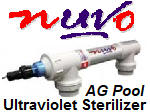 ever seen. The chemistry of
chlorine and bromine is very similar and, in most instances,
it is the bromine that seems to be less irritating. You are
focusing the attention on the bromine part of the molecule.
The other part of the molecule is dimethyl hydantoin or
something closely related. When bromine is added to a pool,
the hydantoin is an unavoidable byproduct and builds up over
time. It is entirely possible that you are sensitive to this
component of the bromine product. Perhaps, you could be
tested for reactions to hydantoin compounds. If you are
truly allergic to bromine and or the hydantoin compounds,
there is nothing that will remove these materials from the
pool water, in the near term, that is short of replacing the
water. That seems to leave you needing to find another pool,
at least temporarily. Many commercial pools have switched,
from a total reliance on chlorine or bromine, to
ozone
generators or
ultraviolet
sterilizers. This helps reduce
odors, destroys organic byproducts and reduces the levels of
chemicals needed for proper sanitation. Good luck with the
resolution of the problem. Please let me know how things
turn out for you.
ever seen. The chemistry of
chlorine and bromine is very similar and, in most instances,
it is the bromine that seems to be less irritating. You are
focusing the attention on the bromine part of the molecule.
The other part of the molecule is dimethyl hydantoin or
something closely related. When bromine is added to a pool,
the hydantoin is an unavoidable byproduct and builds up over
time. It is entirely possible that you are sensitive to this
component of the bromine product. Perhaps, you could be
tested for reactions to hydantoin compounds. If you are
truly allergic to bromine and or the hydantoin compounds,
there is nothing that will remove these materials from the
pool water, in the near term, that is short of replacing the
water. That seems to leave you needing to find another pool,
at least temporarily. Many commercial pools have switched,
from a total reliance on chlorine or bromine, to
ozone
generators or
ultraviolet
sterilizers. This helps reduce
odors, destroys organic byproducts and reduces the levels of
chemicals needed for proper sanitation. Good luck with the
resolution of the problem. Please let me know how things
turn out for you.
Sincerely. Alan Schuster, 4/25/2007
► Stinging
Eyes?
We have a 10,000 gallon pool. Last
year the kids had a few episodes of irritating stinging
eyes. What can I do to avoid this problem again. We will be
opening the pool, in the next week or so. We use trichlor
tablets. Thanks you for the help.
Gerry B., Virginia Beach, VA, 5/3/2007
High levels of chloramines is the most likely cause of
stinging, irritated or red eyes. Ideally, the combined
chlorine level (which primarily consists of chloramines)
should not be more than 0.3 PPM. In practice, 1 PPM is
probably more attainable. Combined Chlorine is the difference between Total Chlorine and Free Chlorine. Shock
treatment is the method of reducing the combined chlorine.
You need 10 PPM of Free Chlorine to destroy 1 PPM of
Combined Chlorine. The pH of the eye is 7.4. pH values that
are much lower or higher can lead to irritating conditions.
The trichlor tablets that you are using will lower the pH
and can produce unacceptably low reading, if you do not make
the proper adjustments. As the pH drops below 7.2, chlorine
becomes more aggressive and irritating. In summation, the
irritations are probably caused by high levels of combined
chlorine and could be made worse by low pH conditions. The
solution: pay more attention to the Free and Total Chlorine
levels, as well as the pH. If there is some money in the
budget, add an
ultraviolet sterilizer. It will drastically
lowered the amount of chlorine the pool will require and
will destroy chloramines and infectious microorganisms, as
the water passed through the unit. You'll still need
chlorine, but a lot less and the conditions will be much
more comfortable. Think about replacing the current chlorine
products with a salt
chlorine generator. The water quality will be
better and maintenance will be easier. I hope that things will work out better
this season. Enjoy the summer.
difference between Total Chlorine and Free Chlorine. Shock
treatment is the method of reducing the combined chlorine.
You need 10 PPM of Free Chlorine to destroy 1 PPM of
Combined Chlorine. The pH of the eye is 7.4. pH values that
are much lower or higher can lead to irritating conditions.
The trichlor tablets that you are using will lower the pH
and can produce unacceptably low reading, if you do not make
the proper adjustments. As the pH drops below 7.2, chlorine
becomes more aggressive and irritating. In summation, the
irritations are probably caused by high levels of combined
chlorine and could be made worse by low pH conditions. The
solution: pay more attention to the Free and Total Chlorine
levels, as well as the pH. If there is some money in the
budget, add an
ultraviolet sterilizer. It will drastically
lowered the amount of chlorine the pool will require and
will destroy chloramines and infectious microorganisms, as
the water passed through the unit. You'll still need
chlorine, but a lot less and the conditions will be much
more comfortable. Think about replacing the current chlorine
products with a salt
chlorine generator. The water quality will be
better and maintenance will be easier. I hope that things will work out better
this season. Enjoy the summer.
Sincerely. Alan Schuster, 5/3/2007
► A Rash From
Cyanuric Acid?
Our pool was recently refinished and
was restarted as new. My wife develops a rash and welts
every time she gets in the pool. This didn't happen in the
old (20 yrs) one. Could she be allergic to the higher level
of cyanuric acid?
Jack S., 9/8/2005
Not likely! If the pool was just refinished, your cyanuric
acid level is near the optimum range. If you used a
stabilized chlorine, in the pool before it was refinished,
it is likely that the cyanuric acid level, at that time, was
very much higher. If a stabilized chlorine was not used, I
suppose there is a possibility that she is sensitive to
cyanuric acid. But, cyanuric acid is present in most
residential pools and has she ever had the problem
elsewhere? You should seek a medical opinion as to the
likely cause of the rash. I hope that I have been helpful.
Sincerely. Alan Schuster, 9/8/2005
► High pH
Rash?
Do you have any detailed information
connecting skin rashes with high water pH?
David G., 4/7/2005
I have no detailed information on this topic. High pH can be
irritating and this can contribute to chemical dermatitis.
If you are experiencing a rash problem, I suggest that you
seek medical attention, for treatment and a proper
diagnosis. In addition, the high pH will reduce the
effectiveness of chlorine and this can lead to conditions
that foster the growth of infectious bacteria. At a pH of
8.0, chlorine has lost 1/2 of its effectiveness. At a pH of
9.0, effectiveness is nearly zero. I hope that I have been
helpful.
Sincerely. Alan Schuster, 4/7/2005
► Wet Bathing
Suit Rash?
I have an above ground pool with a
vinyl liner and every time my son and sometimes my daughter
go in the pool they get a rash in the groin and leg area. I
as well as my wife can go in the pool at the same time and
for the same amount of time as them and we do not get it but
the kids do. I have adjusted the chemicals to the proper
level and keep it that way and do not understand what is
causing this. Is it possible to have an allergic reaction to
the vinyl liner? We have had two different pools in the past
and last year we replaced the liner and since then this has
been happening. The fact that I or my wife do not get the
rash when in the same pool at the same time leads me to
think that the pool may not be the problem have you ever
heard of this happening in the past I am at a loss. We have
explored everything from personal hygiene to pool water
levels and I am wits end with this problem. I appreciate any
help you can give me. Sincerely
Vincent K., Miami, Florida, 9/13/2009
I suggest that you discuss this with the family doctor to be
on the safe side. It sounds like your sanitation could be
borderline. Kids tend to spend lots of time in the pool and
can remain in wet bathing suits long after existing the
pool. The combination of possible borderline sanitation and
wet bathing suits can lead to rashes in the areas that
remain damp for long periods of time. This seems to fit the
facts. I suggest that you pay more attention to the free
chlorine level and use a product such as the
LaMotte
Insta-Test strips. It will help you keep the free
chlorine at 1-3 PPM. In addition to better water chemistry,
get the kids out of the wet bathing suits, as soon as
possible! Because chlorine levels rise and fall, a more
efficient sanitizer will not only help avoid sanitizing
problems, it can allow you to use fewer chemicals overall. A
salt chlorine
generator can produce and maintain the required Free Chlorine
level, is easy to
use and provides more control and better results, than traditional chlorine products. It is a better way to help sanitize your pool. I hope
that I have been helpful. If so, please tell your friends
and dealers about the website.
lots of time in the pool and
can remain in wet bathing suits long after existing the
pool. The combination of possible borderline sanitation and
wet bathing suits can lead to rashes in the areas that
remain damp for long periods of time. This seems to fit the
facts. I suggest that you pay more attention to the free
chlorine level and use a product such as the
LaMotte
Insta-Test strips. It will help you keep the free
chlorine at 1-3 PPM. In addition to better water chemistry,
get the kids out of the wet bathing suits, as soon as
possible! Because chlorine levels rise and fall, a more
efficient sanitizer will not only help avoid sanitizing
problems, it can allow you to use fewer chemicals overall. A
salt chlorine
generator can produce and maintain the required Free Chlorine
level, is easy to
use and provides more control and better results, than traditional chlorine products. It is a better way to help sanitize your pool. I hope
that I have been helpful. If so, please tell your friends
and dealers about the website.
Sincerely. Alan Schuster, 9/14/2009
► Rash Under
Bathing Suit?
My daughter, occasionally, has gotten
a rash under her bathing suit. What is causing this and how
can I help avoid the problem? Thank you for the help.
Jennifer. O., 8/22/2006
This rash problem may or may not have anything to do with
the effectiveness of the pool water maintenance. Obviously,
bad sanitation practices will not help. Kids can spend a lot
of time in the water. However, this is not a kids only
problem. Wet bathing suits and warm bodies can allow for
bacterial growth to occur in the creases of the bathing suit
and the folds of the body. Some people are probably more
sensitive than others. Remaining in a wet bathing for a long
period of time, without going back into the water, is the
likely cause of many bather comfort problems. If you're not
going back into the water - don't hang around in a wet
bathing suit, if possible. A medical opinion should be
sought for evaluation and treatment. I hope that I was of
assistance.
Sincerely. Alan Schuster, 8/22/2006
► Red
Splotches?
Hi, I have just visited your website
and thought to run this question by you. Today I took my
kids to the sitter's house where they have small pool in
their backyard with chemicals in it. But I am not sure what.
When I called to check on my kids she said that my daughter
who is 7 had got out of the pool an hour earlier and was
broke out in red splotches all up and down her arms that
were raised. She said they looked like welts. I have never
heard of anything like this before. What I am wondering is
if you have heard of anyone having that sort of a reaction
to pools like that or if I should search elsewhere for clues
of what it could be. Thanks very much.
Sara J., 5/3/2004
Yes, I have heard of this before. It is a medical matter and
you should seek medical services. There are several
possibilities. Inadequate pool water sanitation leading to a
bacterial rash. Chemical dermatitis, due to improper
chemical levels, and resulting in a chemical rash. Or
sensitivity to something used in the water. Not knowing what
the pool is being sanitized with makes it difficult to be
more specific. If she was the only one affected, that could
indicate a sensitivity, on her part, to the conditions in
that particular pool. I am not qualified to determine which
one is most likely, you'll need a doctor for that. Good luck
and I hope that I have been helpful.
Sincerely. Alan Schuster, 5/3/2004
|
Visit The Website Stores . . . for
better informed shopping!!! |
|
 |
Shipping is FREE* . . . within
the Continental U.S.
A $9.99
handling charge will apply
to Continental U.S. Orders,
under $75.00. Orders
outside of the Continental
U.S. may require some
additional charge, based on
quantity and destination.
Most products can be
shipped World-Wide. International
and orders outside of
Continental U.S. - see
comments on the ordering
pages. |
|
 |

Major
Credit Cards and PayPal are accepted. |
|
▲
Return To Top Of Page
▲
Aqualab Systems, LLC does not
make any warranty or
representation, either expressed
or implied, regarding the
accuracy or completeness of the
information provided by this
website; nor does Aqualab
Systems., LLC. assume any
liability of any kind whatsoever
related to, or resulting from,
any use or reliance on this
information. The content of this
website should not be used, if
it is conflict with any
applicable federal, state or
local regulations or guidelines.
© Aqualab Systems, LLC. All
rights reserved









